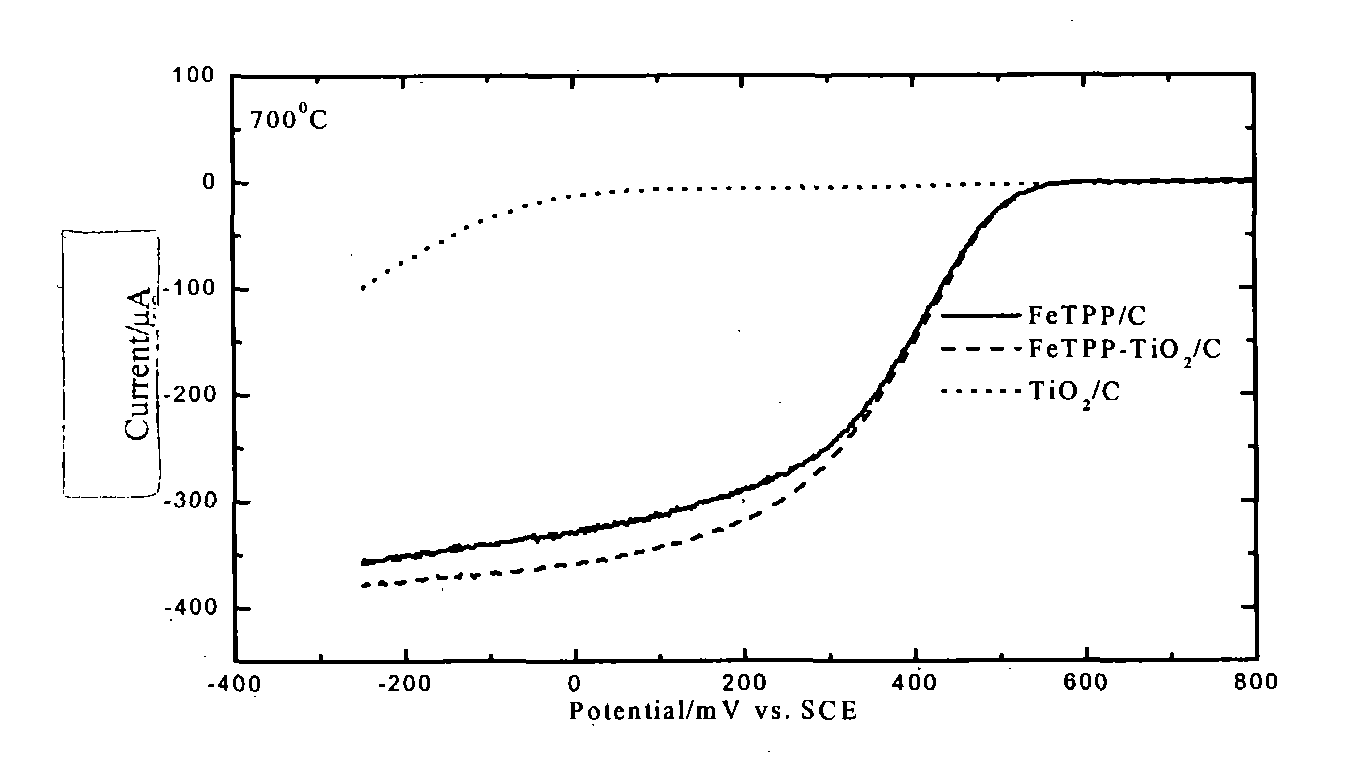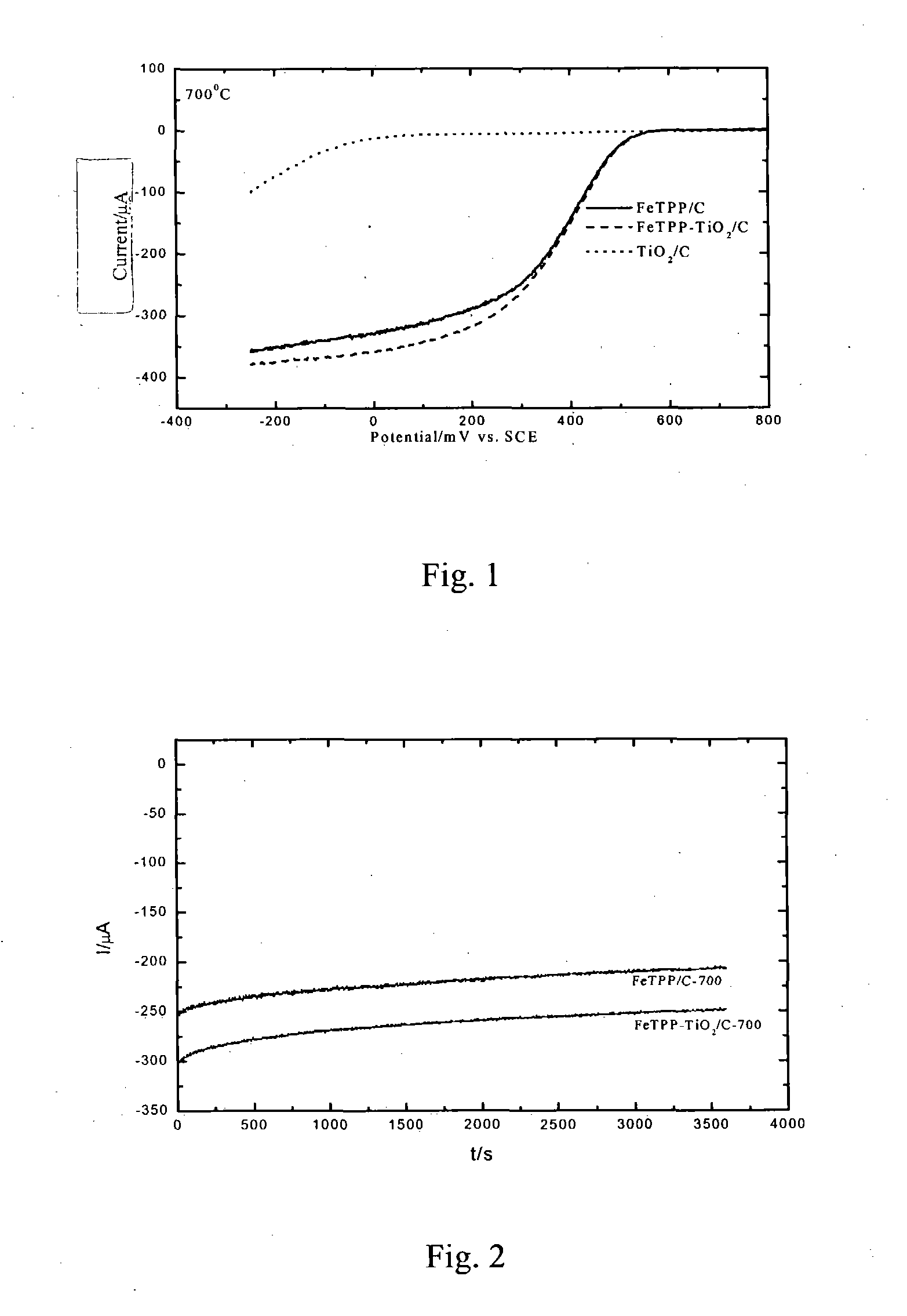Method of preparation of non-platinum composite electrocatalyst for cathode of fuel cell
- Summary
- Abstract
- Description
- Claims
- Application Information
AI Technical Summary
Benefits of technology
Problems solved by technology
Method used
Image
Examples
example 1
[0029] (1) Preparation of carbon supporting titanium dioxide: The volume ratio of the reactants is tetrabutyl titanate:anhydrous ethanol:water:nitric acid=1:100:5:0.4. Tetrabutyl titanate was slowly added into half amount of anhydrous ethanol with vigorous stirring at room temperature to obtain a homogeneous transparent solution (A). Nitric acid was added into a mixed solution of deionized water and other half amount of the anhydrous ethanol with vigorous stirring to obtain a solution (B). Then the solution (A) was slowly dropped into the solution (B) under vigorous stirring to obtain a homogeneous transparent sol. The sol was so blended with the active carbon that the content of the active carbon was 20 g / L. The mixture was stirred and left aside until the completion of the gelating process. The gelled product was vacuum dried to yield the carbon supporting titanium dioxide.
[0030] (2) Preparation of carbon supporting titanium dioxide--transition metal macrocyclic compound: iron-tet...
example 2
[0032] Example 2 was carried out as in Example 1 except that the content of the active carbon in the titanium dioxide sol was 10 g / L, the macrocyclic compound was cobalt-phthalocyanine and was present in the organic solvent at an amount of 5 g / L, and the volume ratio of the deionized water to the organic solvent was 5:1. The finally obtained carbon supporting titanium dioxide-transition metal macrocyclic compound contained 80% by weight of the active carbon. The mass ratio of the transition metal macrocyclic compound to titanium dioxide was 10:1. The resulting product was thermal treated at 1100.degree. C. under the nitrogen atmosphere for 4 hours.
[0033] The activity of the composite catalyst was measured by half-cell method with a rotating circular electrode at room temperature and was found to be roughly identical to that of the corresponding transition metal macrocyclic compound. At 0.45V vs NHE, the current obtained by the composite catalyst was higher than that of the correspon...
example 3
[0034] Example 3 was carried out as in Example 1 except that the content of the active carbon in the titanium dioxide sol was 30 g / L, the macrocyclic compound was zinc-tetracarboxylphthalocyanine and was present in the organic solvent at an amount of 0.5 g / L, and the volume ratio of the deionized water to the organic solvent was 1:2. The finally obtained carbon supporting titanium dioxide-transition metal macrocyclic compound contained 40% by weight of the active carbon. The mass ratio of the transition metal macrocyclic compound to titanium dioxide was 1:2. The resulting product was thermal treated at 100.degree. C. for 0.5 hours.
[0035] The activity of the composite catalyst was measured by half-cell method with a rotating circular electrode at room temperature and was found to be roughly identical to that of the corresponding transition metal macrocyclic compound. At 0.45V vs NHE, the current obtained by the composite catalyst was higher than that of the corresponding macrocyclic ...
PUM
| Property | Measurement | Unit |
|---|---|---|
| Temperature | aaaaa | aaaaa |
| Angle | aaaaa | aaaaa |
| Percent by mass | aaaaa | aaaaa |
Abstract
Description
Claims
Application Information
 Login to View More
Login to View More - R&D
- Intellectual Property
- Life Sciences
- Materials
- Tech Scout
- Unparalleled Data Quality
- Higher Quality Content
- 60% Fewer Hallucinations
Browse by: Latest US Patents, China's latest patents, Technical Efficacy Thesaurus, Application Domain, Technology Topic, Popular Technical Reports.
© 2025 PatSnap. All rights reserved.Legal|Privacy policy|Modern Slavery Act Transparency Statement|Sitemap|About US| Contact US: help@patsnap.com


